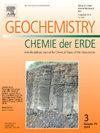阿尔及利亚Hoggar (Tuareg盾)西部新元古代再活动的太古宙-古元古代微大陆的证据:地球动力学演化及其金矿化意义
IF 2.9
3区 地球科学
Q2 GEOCHEMISTRY & GEOPHYSICS
引用次数: 0
摘要
在Hoggar的Tirek地体的西部边界包含阿尔及利亚最大的两个金矿,即Amesmessa和Tirek金矿。新的地质填图及岩石学、地球化学和年代学(U-Pb锆石年代学(LA-)ICP-MS)综合研究结果显示,本区存在古元古代TTG基底,时间为1965±18 Ma(继承锆石时间为2771 ~ 2006 Ma),上覆由石英岩和变质长岩组成的表壳单元。变质岩碎屑锆石的年龄范围从太古宙到古元古代(2710 Ma - 2050 Ma)。亚碱性正长岩的岩脉和岩脉侵入于1843±19 Ma。另一方面,混染花岗岩-花岗闪长岩基占研究面积的50%,侵入所有单元,具有俯冲岩浆作用的亲和性,其年代为663±4 Ma。研究区在顺时针的P-T演化过程中受到HT-LP变质叠印的影响,峰值在800-850℃,5kbar左右,然后减压,然后冷却到600℃,3kbar的P-T条件。单独居石的铀- pb定年为578±5 Ma,反映了变质叠印峰的形成时间与同动花岗岩沿剪切带侵位时间同步。在此活动期间,研究区西部边界东乌扎连剪切带是岩浆侵入和各种流体循环的场所。这促进了一个重要的流体/岩石相互作用事件,导致流体通过岩石渗透提取金,并沿N-S/NE-SW石英脉矿柱沉积。与图阿雷格盾的西部地体(In Ouzzal、Iforas、Tassendjanet和Kidal地体)的比较表明,图阿雷格地体和这些地体代表了一个太古代-古元古代大陆的遗迹。目前,太古宙下地壳在这个微大陆的中部交叉。后者主要受古元古代麻粒岩相变质作用的影响,而古元古代中地壳两侧露露,在泛非造山运动(850-570 Ma)期间被强烈地重新活化,在该事件后期形成了金矿化。本文章由计算机程序翻译,如有差异,请以英文原文为准。
Evidence of an Archean-Paleoproterozoic micro-continent remobilized during the Neoproterozoic from the western Hoggar (Tuareg Shield, Algeria): Geodynamic evolution and implication on gold mineralization
The western boundary of the Tirek terrane in the Hoggar contains the two largest gold deposits in Algeria, namely the Amesmessa and Tirek gold fields. New geological mapping of this area and results of a combined petrological, geochemical and geochronological study (U-Pb zircon geochronological (LA-)ICP-MS method) reveals a Paleoproterozoic TTG basement, dated at 1965 ± 18 Ma (inherited zircons from 2771 to 2006 Ma), overlain by a supracrustal unit made up of quartzites and metapelites. Detrital zircons from metapelites yielded ages ranging from Archaean to Paleoproterozoic (2710 Ma–2050 Ma). Furthermore, sills and dykes of sub-alkaline orthogneisses that intrude the previous lithologies have been dated at 1843 ± 19 Ma. On the other hand, the migmatitic granitic-granodioritic batholith, which covers 50 % of the studied area and intrudes all units, has a subduction magmatism affinity and is dated at 663 ± 4 Ma.
The study area was affected by a HT-LP metamorphic overprint during a clockwise P-T evolution with a peak conditions around 800–850 °C at 5 kbar followed by a decompression, then a cooling reaching the P-T conditions of 600 °C and 3 kbar. Uranium-Pb dating of monazite yields an age of 578 ± 5 Ma, which is interpreted to reflect the time of peak metamorphic overprint synchronous with the emplacement of synkinematic granites along shear zones with transcurrent movement. During this event, the western border of the studied area, the East Ouzzalian Shear zone, was the site of magmatic intrusions as well as the circulation of various fluids. This promoted an important fluid/rock interaction event, leading to extraction of gold by fluid percolation through the rocks and its deposition along N-S/NE-SW quartz vein ore shoots. The comparison with the western terranes of the Tuareg Shield (In Ouzzal, Iforas, Tassendjanet, and Kidal terranes) suggests that Tirek and these terranes represent relics of a single Archean-Paleoproterozoic continent. Currently, the Archean lower crust cross out in the central part of this micro-continent. The latter is mainly affected by Paleoproterozoic granulite facies metamorphism, unlike the Paleoproterozoic middle crust, which is exposed on either side and was strongly remobilized during the Pan-African orogeny (850–570 Ma), allowing gold mineralization during the later stages of this event.
求助全文
通过发布文献求助,成功后即可免费获取论文全文。
去求助
来源期刊

Chemie Der Erde-Geochemistry
地学-地球化学与地球物理
CiteScore
7.10
自引率
0.00%
发文量
40
审稿时长
3.0 months
期刊介绍:
GEOCHEMISTRY was founded as Chemie der Erde 1914 in Jena, and, hence, is one of the oldest journals for geochemistry-related topics.
GEOCHEMISTRY (formerly Chemie der Erde / Geochemistry) publishes original research papers, short communications, reviews of selected topics, and high-class invited review articles addressed at broad geosciences audience. Publications dealing with interdisciplinary questions are particularly welcome. Young scientists are especially encouraged to submit their work. Contributions will be published exclusively in English. The journal, through very personalized consultation and its worldwide distribution, offers entry into the world of international scientific communication, and promotes interdisciplinary discussion on chemical problems in a broad spectrum of geosciences.
The following topics are covered by the expertise of the members of the editorial board (see below):
-cosmochemistry, meteoritics-
igneous, metamorphic, and sedimentary petrology-
volcanology-
low & high temperature geochemistry-
experimental - theoretical - field related studies-
mineralogy - crystallography-
environmental geosciences-
archaeometry
 求助内容:
求助内容: 应助结果提醒方式:
应助结果提醒方式:


